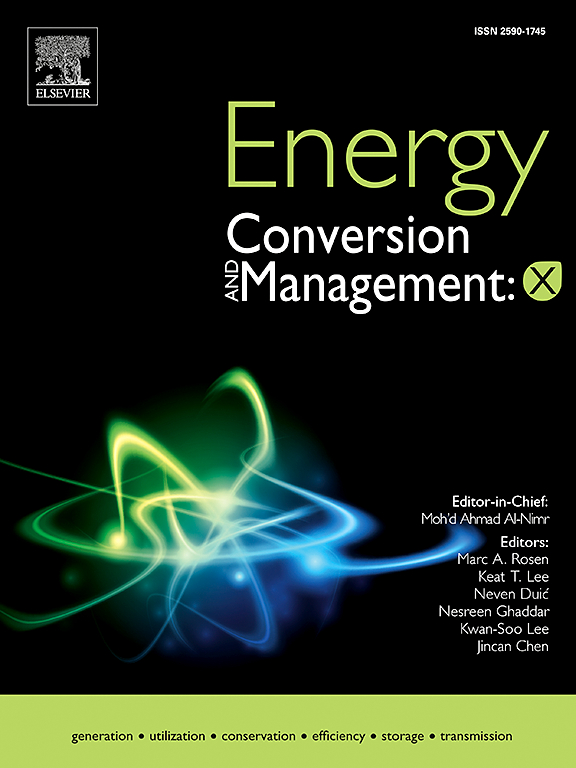Optimization of coal sustainability via hybrid renewable integration: A PVsyst-HOMER Synergistic framework for sustainable energy transitions
IF 7.1
Q1 ENERGY & FUELS
引用次数: 0
Abstract
The growing urgency to decarbonize power systems while maintaining grid reliability has made hybrid energy systems an increasingly attractive solution, especially for coal-dependent regions. This study presents a novel hybrid energy optimization framework that integrates photovoltaic (PV), hydropower, and coal-based generation to enable a cost-effective and reliable power supply while facilitating a gradual transition toward low-carbon energy systems. Unlike conventional models that aim for immediate fossil fuel phase-out, this study proposes a pragmatic bridge model that utilizes existing coal infrastructure as dispatchable backup, enhancing grid stability without compromising sustainability goals. The methodology involves technical and economic modelling using HOMER Pro for hybrid system optimization and PVsyst for accurate PV performance analysis. Multiple constraints, including net present cost (NPC), cost of electricity (COE), reserve margin (≥15 %), CO2 emissions threshold (≤30 % above baseline), and annual unmet load (≤0.5 %) are considered. A detailed sensitivity analysis was conducted to evaluate system robustness under varying solar irradiance and demand conditions. Results show that the optimized hybrid system (120 MW PV, 111 MW coal, 151 MW hydro) achieves the lowest COE ($0.0547/kWh) and CO2 emissions (83,115,000 kg/year) with minimal unmet load (0.03 %). Environmental aspects are considered through explicit modelling of CO2, SO2, and NOx emissions, as well as scenario-based carbon taxation. A high system performance ratio of 81.3 % and a capacity factor of 68.8 %, confirming the system’s technical and economic viability. The findings underscore the importance of flexible, region-specific energy strategies and provide a replicable methodology for investors, utilities, and governments seeking to balance energy security, environmental impact, and economic growth on the path toward carbon–neutral power systems. This research offers a versatile and globally applicable approach that can guide researchers in developing hybrid systems tailored to different geographic, climatic, and economic contexts, supporting worldwide efforts in sustainable energy transitions.
通过混合可再生能源整合优化煤炭可持续性:可持续能源转型的pvsystem - homer协同框架
在保持电网可靠性的同时使电力系统脱碳的紧迫性日益增加,这使得混合能源系统成为越来越有吸引力的解决方案,特别是在依赖煤炭的地区。本研究提出了一种新的混合能源优化框架,该框架集成了光伏(PV),水电和煤炭发电,以实现经济可靠的电力供应,同时促进向低碳能源系统的逐步过渡。与旨在立即淘汰化石燃料的传统模型不同,本研究提出了一种实用的桥梁模型,该模型利用现有的煤炭基础设施作为可调度的备份,在不影响可持续性目标的情况下提高电网稳定性。该方法包括技术和经济建模,使用HOMER Pro进行混合系统优化,使用PVsyst进行准确的光伏性能分析。考虑了多种约束条件,包括净当前成本(NPC)、电力成本(COE)、储备边际(≥15%)、二氧化碳排放阈值(比基线高≤30%)和年未满足负荷(≤0.5%)。进行了详细的灵敏度分析,以评估系统在不同太阳辐照度和需求条件下的鲁棒性。结果表明,优化后的混合系统(120 MW光伏、111 MW煤、151 MW水电)在未满足负荷最小(0.03%)的情况下,实现了最低的COE(0.0547美元/千瓦时)和二氧化碳排放量(83,115,000 kg/年)。通过对二氧化碳、二氧化硫和氮氧化物排放的明确建模,以及基于情景的碳税,考虑了环境方面。系统的高性能比达到81.3%,容量系数达到68.8%,证实了系统的技术和经济可行性。研究结果强调了灵活的、针对特定地区的能源战略的重要性,并为寻求在通往碳中和电力系统的道路上平衡能源安全、环境影响和经济增长的投资者、公用事业公司和政府提供了一种可复制的方法。这项研究提供了一种通用的、全球适用的方法,可以指导研究人员开发适合不同地理、气候和经济背景的混合系统,支持全球可持续能源转型的努力。
本文章由计算机程序翻译,如有差异,请以英文原文为准。
求助全文
约1分钟内获得全文
求助全文
来源期刊

Energy Conversion and Management-X
Multiple-
CiteScore
8.80
自引率
3.20%
发文量
180
审稿时长
58 days
期刊介绍:
Energy Conversion and Management: X is the open access extension of the reputable journal Energy Conversion and Management, serving as a platform for interdisciplinary research on a wide array of critical energy subjects. The journal is dedicated to publishing original contributions and in-depth technical review articles that present groundbreaking research on topics spanning energy generation, utilization, conversion, storage, transmission, conservation, management, and sustainability.
The scope of Energy Conversion and Management: X encompasses various forms of energy, including mechanical, thermal, nuclear, chemical, electromagnetic, magnetic, and electric energy. It addresses all known energy resources, highlighting both conventional sources like fossil fuels and nuclear power, as well as renewable resources such as solar, biomass, hydro, wind, geothermal, and ocean energy.
 求助内容:
求助内容: 应助结果提醒方式:
应助结果提醒方式:


